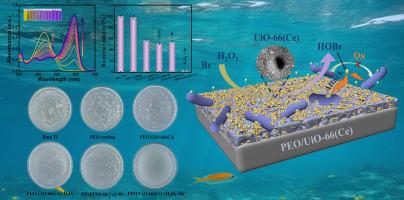In-situ growth of PEO/UiO-66(Ce) nanozyme coatings on titanium alloy for antibacterial applications
IF 6.1
2区 材料科学
Q1 MATERIALS SCIENCE, COATINGS & FILMS
引用次数: 0
Abstract
Titanium and titanium alloys face limitations in marine engineering applications due to biofouling. Traditional toxic antifouling coatings contribute to environmental accumulation and biological resistance. Although the nanocatalytic antifouling strategy based on algal enzyme mechanisms shows promise, its effectiveness is limited by resin-based immobilization methods that hinder the exposure of active sites. In this study, we propose an innovative strategy that integrates plasma electrolytic oxidation (PEO) with chemical etching and a solvothermal method to in-situ construct a PEO/UiO-66(Ce) nanozyme coating on the titanium alloy surface. The nanozymes are uniformly anchored on the surface of the TiO2 porous ceramic layer through hydroxyl interactions and confinement with the hydroxyl-rich nanonetwork, thereby ensuring good structural stability. The sufficient exposure of the active sites facilitates the efficient conversion of H2O2 and Br− to HOBr at the catalytic interface. As a result, the PEO/UiO-66(Ce) coating exhibits excellent haloperoxidase-like activity (HPO) and remarkable performance stability. Antibacterial tests show that the PEO/UiO-66(Ce) coating achieves a 97.8 % antibacterial rate against E. coli in the presence of H2O2 and Br−. Compared to the original TA1, PEO/UiO-66(Ce) significantly reduces the attachment of marine algae, with a coverage rate of only 3.4 % after three days of immersion in Halamphora sp. suspension, which is substantially lower than the 27.6 % observed for TA1. Furthermore, its corrosion current density in a 3.5 % NaCl solution is significantly lower than that of pure TA1. This study provides new insights into the development of high-performance, non-toxic, and environmentally friendly bio-inspired antifouling coatings.

PEO/UiO-66(Ce)纳米酶涂层在钛合金表面的原位生长及其抗菌性能
由于生物污染,钛和钛合金在海洋工程中的应用受到限制。传统的有毒防污涂料有助于环境积累和生物抗性。尽管基于藻类酶机制的纳米催化防污策略显示出前景,但其有效性受到树脂固定方法的限制,这些方法阻碍了活性位点的暴露。在这项研究中,我们提出了一种创新的策略,将等离子体电解氧化(PEO)与化学蚀刻和溶剂热方法相结合,在钛合金表面原位构建PEO/UiO-66(Ce)纳米酶涂层。纳米酶通过羟基相互作用和与富羟基纳米网络的约束,均匀地固定在TiO2多孔陶瓷层表面,从而保证了良好的结构稳定性。活性位点的充分暴露有利于H2O2和Br−在催化界面上高效转化为HOBr。结果表明,PEO/UiO-66(Ce)涂层具有优异的类卤过氧化物酶活性(HPO)和优异的性能稳定性。抑菌试验表明,PEO/UiO-66(Ce)涂层在H2O2和Br−存在下对大肠杆菌的抑菌率达到97.8%。与原始TA1相比,PEO/UiO-66(Ce)显著降低了海藻的附着,在Halamphora sp.悬浮液中浸泡3天后,其附着覆盖率仅为3.4%,大大低于TA1的27.6%。在3.5% NaCl溶液中,其腐蚀电流密度明显低于纯TA1。本研究为开发高性能、无毒、环保的仿生防污涂料提供了新的思路。
本文章由计算机程序翻译,如有差异,请以英文原文为准。
求助全文
约1分钟内获得全文
求助全文
来源期刊

Surface & Coatings Technology
工程技术-材料科学:膜
CiteScore
10.00
自引率
11.10%
发文量
921
审稿时长
19 days
期刊介绍:
Surface and Coatings Technology is an international archival journal publishing scientific papers on significant developments in surface and interface engineering to modify and improve the surface properties of materials for protection in demanding contact conditions or aggressive environments, or for enhanced functional performance. Contributions range from original scientific articles concerned with fundamental and applied aspects of research or direct applications of metallic, inorganic, organic and composite coatings, to invited reviews of current technology in specific areas. Papers submitted to this journal are expected to be in line with the following aspects in processes, and properties/performance:
A. Processes: Physical and chemical vapour deposition techniques, thermal and plasma spraying, surface modification by directed energy techniques such as ion, electron and laser beams, thermo-chemical treatment, wet chemical and electrochemical processes such as plating, sol-gel coating, anodization, plasma electrolytic oxidation, etc., but excluding painting.
B. Properties/performance: friction performance, wear resistance (e.g., abrasion, erosion, fretting, etc), corrosion and oxidation resistance, thermal protection, diffusion resistance, hydrophilicity/hydrophobicity, and properties relevant to smart materials behaviour and enhanced multifunctional performance for environmental, energy and medical applications, but excluding device aspects.
 求助内容:
求助内容: 应助结果提醒方式:
应助结果提醒方式:


